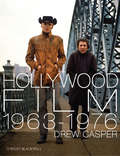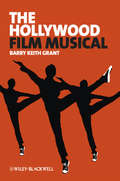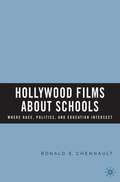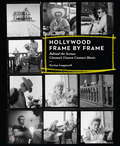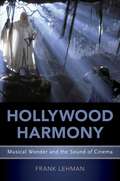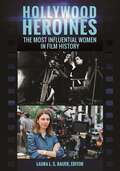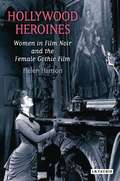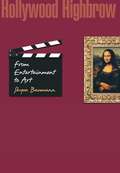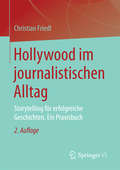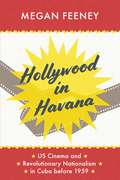- Table View
- List View
Hollywood Film 1963-1976: Years of Revolution and Reaction
by Drew CasperHollywood 1963-1976 chronicles the upheaval and innovation that took place in the American film industry during an era of pervasive cultural tumult. Exploring the many ideologies embraced by an increasingly diverse Hollywood, Casper offers a comprehensive canon, covering the period's classics as well as its brilliant but overlooked masterpieces. A broad overview and analysis of one of American film's most important and innovative periods Offers a new, more expansive take on the accepted canon of the era Includes films expressing ideologies contrary to the misremembered leftist slant Explores and fully contextualizes the dominant genres of the 60s and 70s
Hollywood Film 1963-1976: Years of Revolution and Reaction
by Drew CasperHollywood 1963-1976 chronicles the upheaval and innovation that took place in the American film industry during an era of pervasive cultural tumult. Exploring the many ideologies embraced by an increasingly diverse Hollywood, Casper offers a comprehensive canon, covering the period's classics as well as its brilliant but overlooked masterpieces. A broad overview and analysis of one of American film's most important and innovative periods Offers a new, more expansive take on the accepted canon of the era Includes films expressing ideologies contrary to the misremembered leftist slant Explores and fully contextualizes the dominant genres of the 60s and 70s
The Hollywood Film Musical (New Approaches to Film Genre #24)
by Barry Keith GrantThis revealing history of the American film musical synthesizes the critical literature on the genre and provides a series of close analytical readings of iconic musical films, focusing on their cultural relationship to other aspects of American popular music. Offers a depth of scholarship that will appeal to students and scholars Leads a crucial analysis of the cultural context of musicals, particularly the influence of popular music on the genre Delves into critical issues behind these films such as race, gender, ideology, and authorship Features close readings of canonical and neglected film musicals from the 1930s to the present including: Top Hat, Singin' in the Rain, Woodstock, Gimme Shelter, West Side Story, and Across the Universe
The Hollywood Film Musical (New Approaches to Film Genre #23)
by Barry Keith GrantThis revealing history of the American film musical synthesizes the critical literature on the genre and provides a series of close analytical readings of iconic musical films, focusing on their cultural relationship to other aspects of American popular music. Offers a depth of scholarship that will appeal to students and scholars Leads a crucial analysis of the cultural context of musicals, particularly the influence of popular music on the genre Delves into critical issues behind these films such as race, gender, ideology, and authorship Features close readings of canonical and neglected film musicals from the 1930s to the present including: Top Hat, Singin' in the Rain, Woodstock, Gimme Shelter, West Side Story, and Across the Universe
Hollywood Films about Schools: Where Race, Politics, and Education Intersect
by R. ChennaultWhat do the Hollywood 'school films' of the 1980's and 1990's communicate about education and race? This book looks at The Graduate , Blackboard Jungle , The English Patient , Dead Poets Society , Pulp Fiction , Ghost , The Wizard of Oz , Top Gun and Forrest Gump to answer the question.
Hollywood Frame by Frame: Behind the Scenes: Cinema's Unseen Contact Sheets
by Karina LongworthThis is your illustrated invitation to the moments when movie history was made. Photographers' contact sheets are the permanent record of every shot that they took - and through Hollywood's golden age, there was often a photographer on set, capturing the scene as actors and directors collaborated to produce classic movies. This book collects the contact sheets from classic movies like The African Queen (1951), Some Like it Hot (1959), Taxi Driver (1976), Grosse Point Blank (1997) and many more. Capturing legends such as Woody Allen, Audrey Hepburn, Alfred Hitchcock, Marilyn Monroe, and Frank Sinatra at work and at repose, these images offer rare glimpses into the art of moviemaking, the science of movie marketing, and the nature of stardom.
Hollywood Genres and Postwar America: Masculinity, Family and Nation in Popular Movies and Film Noir (Cinema and Society)
by Mike Chopra-GantThis is a clear and engrossing account of how popular films in America just after the close of the Second World War played out America's mood at that crucial time. It is also a revisionist challenge to received scholarly understanding of this mood, which has tended to be seen as characterized by an abiding pessimism most clearly manifested in the films noir of the period. Chopra-Gant makes here an important contribution to film genre, which, while not denying the significance of film noir, proposes that the 'noir and Zeitgeist' reading relies on a retrospective re-imagining of the era, based on the erroneous promotion of selected movies. He turns to the top box office successes of the period, including 'Best Years of our Lives' and 'Two Years Before the Mast', showing that these films, most popular with audiences of the time, emphasise rather the triumph of American beliefs in democracy, classlessness and individualism. The book is a compelling argument for attention to be given to the more fluid, contemporary understandings of the generic character of films, in contrast to the more rigid genre classes more familiar in film studies scholarship.
Hollywood Harmony: Musical Wonder and the Sound of Cinema (Oxford Music/Media Series)
by Frank LehmanFilm music often tells us how to feel, but it also guides us how to hear. Filmgoing is an intensely musical experience, one in which the soundtrack structures our interpretations and steers our emotions. Hollywood Harmony explores the inner workings of film music, bringing together tools from music theory, musicology, and music psychology in this first ever book-length analytical study of this culturally central repertoire. Harmony, and especially chromaticism, is emblematic of the "film music sound," and it is often used to evoke that most cinematic of feelings-wonder. To help parse this familiar but complex musical style, Hollywood Harmony offers a first-of-its kind introduction to neo-Riemannian theory, a recently developed and versatile method of understanding music as a dynamic and transformational process, rather than a series of inert notes on a page. This application of neo-Riemannian theory to film music is perfect way in for curious newcomers, while also constituting significant scholarly contribution to the larger discipline of music theory. Author Frank Lehman draws from his extensive knowledge of cinematic history with case-studies that range from classics of Golden Age Hollywood to massive contemporary franchises to obscure cult-films. Special emphasis is placed on scores for major blockbusters such as Lord of the Rings, Star Wars, and Inception. With over a hundred meticulously transcribed music examples and more than two hundred individual movies discussed, Hollywood Harmony will fascinate any fan of film and music.
HOLLYWOOD HARMONY OMMS C: Musical Wonder and the Sound of Cinema (Oxford Music/Media Series)
by Frank LehmanFilm music often tells us how to feel, but it also guides us how to hear. Filmgoing is an intensely musical experience, one in which the soundtrack structures our interpretations and steers our emotions. Hollywood Harmony explores the inner workings of film music, bringing together tools from music theory, musicology, and music psychology in this first ever book-length analytical study of this culturally central repertoire. Harmony, and especially chromaticism, is emblematic of the "film music sound," and it is often used to evoke that most cinematic of feelings-wonder. To help parse this familiar but complex musical style, Hollywood Harmony offers a first-of-its kind introduction to neo-Riemannian theory, a recently developed and versatile method of understanding music as a dynamic and transformational process, rather than a series of inert notes on a page. This application of neo-Riemannian theory to film music is perfect way in for curious newcomers, while also constituting significant scholarly contribution to the larger discipline of music theory. Author Frank Lehman draws from his extensive knowledge of cinematic history with case-studies that range from classics of Golden Age Hollywood to massive contemporary franchises to obscure cult-films. Special emphasis is placed on scores for major blockbusters such as Lord of the Rings, Star Wars, and Inception. With over a hundred meticulously transcribed music examples and more than two hundred individual movies discussed, Hollywood Harmony will fascinate any fan of film and music.
Hollywood Hellraisers: The Wild Lives and Fast Times of Marlon Brando, Dennis Hopper, Warren Beatty and Jack Nicholson
by Robert Sellers'I don't know what people expect when they meet me. They seem to be afraid that I'm going to piss in the potted palm and slap them on the ass.' Marlon Brando'I should have been dead ten times over. I believe in miracles. It's an absolute miracle that I'm still around.' Dennis Hopper'The best time to get married is noon. That way, if things don't work out, you haven't blown the whole day.' Warren Beatty'You only lie to two people in your life: your girlfriend and the police.' Jack NicholsonThey're the baddest bad asses Hollywood has ever seen: Marlon Brando, Dennis Hopper, Warren Beatty and Jack Nicholson. These are men for whom rules did not apply, men for whom normal standards of behaviour were simply too wearisome to worry about. These are men who brawled, boozed, snorted and shagged their way into legend-hood - but along the way they changed acting and the way movies were made forever.Hollywood Hellraisers is a whistle-stop tour of jaw-dropping sexual activity, misbehaviour of an Olympic standard, all-out excess and genuine madness. It's a wonder Hollywood survived.
Hollywood Heroines: The Most Influential Women in Film History
by Laura L. S. BauerThis is a topical resource that provides a comprehensive look at the most influential women in Hollywood cinema across a wide-range of occupations rarely found together in a single volume.Unlike other anthologies, Hollywood Heroines: The Most Influential Women in Film History is a hybrid of film history and industry information with an exclusive focus on prominent women. This reference work includes more commonly discussed categories of important women in Hollywood film history, such as directors and actresses, and reaches beyond them to encompass women working as cinematographers, casting directors, studio heads, musical composers, and visual and special effects supervisors. The wide range of filmmaking crafts covered in the book provides an acute view of the industry and increases the visibility of and quality of representation for women working in Hollywood. By bringing the experience of these influential women to light, Hollywood Heroines joins a growing movement that endeavors to dismantle harmful, long-standing industry myths that perpetuate the systemic underrepresentation of women and the devaluation of women's stories in the Hollywood film industry.
Hollywood Heroines: Women in Film Noir and the Female Gothic Film
by Helen HansonThe endangered and dangerous female figures of 'Rebecca', of 'Jagged Edge' and 'What Lies Beneath' have a deserved and enduring fascination. Helen Hanson re-examines these gothic heroines of Hollywood and their meanings, in two of Hollywood's key generic cycles, film noir and the female gothic film. Starting at the beginning, with the origin of these cycles and the ways in which they represented women in the American film industry and culture of the 1940s, she traces their revival in neo-noir and neo-gothic films from the 1980s to the present. She also places the female figures of the femme fatale, female investigator and gothic heroine within the shifting contexts of the film industry and debates in feminist film criticism. Hanson examines a wide range of films from both periods, including 'Suspicion', 'Gaslight' and 'Pacific Heights', and gives particular attention to their presentation of female stories, actions and perspectives. She reveals a diversity of female figures, representations and actions in film noir and the female gothic film, and argues that these women are part of a negotiation of female identities, desires and roles across a long historical period. 'Hollywood Heroines' therefore offers us new ways of thinking about classic and contemporary Hollywood heroines, and about the interrelationships of gender and genre.
Hollywood Heroines: The Most Influential Women in Film History
by Laura L. S. Bauer, EditorThis is a topical resource that provides a comprehensive look at the most influential women in Hollywood cinema across a wide-range of occupations rarely found together in a single volume.Unlike other anthologies, Hollywood Heroines: The Most Influential Women in Film History is a hybrid of film history and industry information with an exclusive focus on prominent women. This reference work includes more commonly discussed categories of important women in Hollywood film history, such as directors and actresses, and reaches beyond them to encompass women working as cinematographers, casting directors, studio heads, musical composers, and visual and special effects supervisors. The wide range of filmmaking crafts covered in the book provides an acute view of the industry and increases the visibility of and quality of representation for women working in Hollywood. By bringing the experience of these influential women to light, Hollywood Heroines joins a growing movement that endeavors to dismantle harmful, long-standing industry myths that perpetuate the systemic underrepresentation of women and the devaluation of women's stories in the Hollywood film industry.
Hollywood Highbrow: From Entertainment to Art
by Shyon BaumannToday's moviegoers and critics generally consider some Hollywood products--even some blockbusters--to be legitimate works of art. But during the first half century of motion pictures very few Americans would have thought to call an American movie "art." Up through the 1950s, American movies were regarded as a form of popular, even lower-class, entertainment. By the 1960s and 1970s, however, viewers were regularly judging Hollywood films by artistic criteria previously applied only to high art forms. In Hollywood Highbrow, Shyon Baumann for the first time tells how social and cultural forces radically changed the public's perceptions of American movies just as those forces were radically changing the movies themselves. The development in the United States of an appreciation of film as an art was, Baumann shows, the product of large changes in Hollywood and American society as a whole. With the postwar rise of television, American movie audiences shrank dramatically and Hollywood responded by appealing to richer and more educated viewers. Around the same time, European ideas about the director as artist, an easing of censorship, and the development of art-house cinemas, film festivals, and the academic field of film studies encouraged the idea that some American movies--and not just European ones--deserved to be considered art.
Hollywood Highbrow: From Entertainment to Art (PDF) (Princeton Studies in Cultural Sociology #30)
by Shyon BaumannToday's moviegoers and critics generally consider some Hollywood products--even some blockbusters--to be legitimate works of art. But during the first half century of motion pictures very few Americans would have thought to call an American movie "art." Up through the 1950s, American movies were regarded as a form of popular, even lower-class, entertainment. By the 1960s and 1970s, however, viewers were regularly judging Hollywood films by artistic criteria previously applied only to high art forms. In Hollywood Highbrow, Shyon Baumann for the first time tells how social and cultural forces radically changed the public's perceptions of American movies just as those forces were radically changing the movies themselves. The development in the United States of an appreciation of film as an art was, Baumann shows, the product of large changes in Hollywood and American society as a whole. With the postwar rise of television, American movie audiences shrank dramatically and Hollywood responded by appealing to richer and more educated viewers. Around the same time, European ideas about the director as artist, an easing of censorship, and the development of art-house cinemas, film festivals, and the academic field of film studies encouraged the idea that some American movies--and not just European ones--deserved to be considered art.
Hollywood im journalistischen Alltag: Storytelling für erfolgreiche Geschichten. Ein Praxisbuch
by Christian FriedlDer Band beantwortet die Frage: Was ist eine Geschichte und wie erzähle ich sie am besten? Er greift dabei das zentrale Motiv der "Heldenreise" auf. Sie ist eine Art Baukasten, aus dem sich Geschichtenerzähler kinderleicht bedienen können. Im Prinzip handelt es sich um eine angereicherte Form der 3-Akt-Struktur nach Aristoteles. Alle berühmten Hollywood-Regisseure benutzen sie, kaum ein Blockbuster kommt ohne sie aus. Was für Hollywood gilt, sollte auch für den Journalismus möglich sein, denn das Übernehmen von Erzählformen ist keine Frage des Geldes. Dieses Buch enthält Drehbuch-Ausschnitte aus Hollywood-Filmen, um die dramaturgischen Strukturen zu erläutern und veranschaulicht anhand von zahlreichen Beispielen aus Fernsehen, Hörfunk und Zeitung, wie man sie im Alltag anwenden kann. Für die zweite Auflage wurden die Filmbeispiele aktualisiert, der theoretische Teil um die Sequenzierung erweitert sowie weitere Beispiele aus dem journalistischen Alltag ergänzt.
Hollywood in Crisis or: The Collapse of the Real
by Wheeler Winston DixonThis book discusses the collapse and transformation of the Hollywood movie machine in the twenty-first century, and the concomitant social collapse being felt in nearly every aspect of society. Wheeler Winston Dixon examines key works in cinema from the era of late-stage capitalists, analyzing Hollywood films and the current wave of cinema developed outside of the Hollywood system alike. Dixon illustrates how movies and television programs across these spaces have adopted, reflected, and generated a society in crisis, and with it, a crisis for the cinematic industry itself.
Hollywood in Havana: US Cinema and Revolutionary Nationalism in Cuba before 1959
by Megan FeeneyFrom the turn of the twentieth century through the late 1950s, Havana was a locus for American movie stars, with glamorous visitors including Errol Flynn, John Wayne, and Marlon Brando. In fact, Hollywood was seemingly everywhere in pre-Castro Havana, with movie theaters three to a block in places, widely circulated silver screen fanzines, and terms like “cowboy” and “gangster” entering Cuban vernacular speech. Hollywood in Havana uses this historical backdrop as the catalyst for a startling question: Did exposure to half a century of Hollywood pave the way for the Cuban Revolution of 1959? Megan Feeney argues that the freedom fighting extolled in American World War II dramas and the rebellious values and behaviors seen in postwar film noir helped condition Cuban audiences to expect and even demand purer forms of Cuban democracy and national sovereignty. At the same time, influential Cuban intellectuals worked to translate Hollywood ethics into revolutionary rhetoric—which, ironically, led to pointed critiques and subversions of the US presence in Cuba. Hollywood in Havana not only expands our notions of how American cinema was internalized around the world—it also broadens our view of the ongoing history of US-Cuban interactions, both cultural and political.
Hollywood in Havana: US Cinema and Revolutionary Nationalism in Cuba before 1959
by Megan FeeneyFrom the turn of the twentieth century through the late 1950s, Havana was a locus for American movie stars, with glamorous visitors including Errol Flynn, John Wayne, and Marlon Brando. In fact, Hollywood was seemingly everywhere in pre-Castro Havana, with movie theaters three to a block in places, widely circulated silver screen fanzines, and terms like “cowboy” and “gangster” entering Cuban vernacular speech. Hollywood in Havana uses this historical backdrop as the catalyst for a startling question: Did exposure to half a century of Hollywood pave the way for the Cuban Revolution of 1959? Megan Feeney argues that the freedom fighting extolled in American World War II dramas and the rebellious values and behaviors seen in postwar film noir helped condition Cuban audiences to expect and even demand purer forms of Cuban democracy and national sovereignty. At the same time, influential Cuban intellectuals worked to translate Hollywood ethics into revolutionary rhetoric—which, ironically, led to pointed critiques and subversions of the US presence in Cuba. Hollywood in Havana not only expands our notions of how American cinema was internalized around the world—it also broadens our view of the ongoing history of US-Cuban interactions, both cultural and political.
Hollywood in Havana: US Cinema and Revolutionary Nationalism in Cuba before 1959
by Megan FeeneyFrom the turn of the twentieth century through the late 1950s, Havana was a locus for American movie stars, with glamorous visitors including Errol Flynn, John Wayne, and Marlon Brando. In fact, Hollywood was seemingly everywhere in pre-Castro Havana, with movie theaters three to a block in places, widely circulated silver screen fanzines, and terms like “cowboy” and “gangster” entering Cuban vernacular speech. Hollywood in Havana uses this historical backdrop as the catalyst for a startling question: Did exposure to half a century of Hollywood pave the way for the Cuban Revolution of 1959? Megan Feeney argues that the freedom fighting extolled in American World War II dramas and the rebellious values and behaviors seen in postwar film noir helped condition Cuban audiences to expect and even demand purer forms of Cuban democracy and national sovereignty. At the same time, influential Cuban intellectuals worked to translate Hollywood ethics into revolutionary rhetoric—which, ironically, led to pointed critiques and subversions of the US presence in Cuba. Hollywood in Havana not only expands our notions of how American cinema was internalized around the world—it also broadens our view of the ongoing history of US-Cuban interactions, both cultural and political.
Hollywood in Havana: US Cinema and Revolutionary Nationalism in Cuba before 1959
by Megan FeeneyFrom the turn of the twentieth century through the late 1950s, Havana was a locus for American movie stars, with glamorous visitors including Errol Flynn, John Wayne, and Marlon Brando. In fact, Hollywood was seemingly everywhere in pre-Castro Havana, with movie theaters three to a block in places, widely circulated silver screen fanzines, and terms like “cowboy” and “gangster” entering Cuban vernacular speech. Hollywood in Havana uses this historical backdrop as the catalyst for a startling question: Did exposure to half a century of Hollywood pave the way for the Cuban Revolution of 1959? Megan Feeney argues that the freedom fighting extolled in American World War II dramas and the rebellious values and behaviors seen in postwar film noir helped condition Cuban audiences to expect and even demand purer forms of Cuban democracy and national sovereignty. At the same time, influential Cuban intellectuals worked to translate Hollywood ethics into revolutionary rhetoric—which, ironically, led to pointed critiques and subversions of the US presence in Cuba. Hollywood in Havana not only expands our notions of how American cinema was internalized around the world—it also broadens our view of the ongoing history of US-Cuban interactions, both cultural and political.
Hollywood in Havana: US Cinema and Revolutionary Nationalism in Cuba before 1959
by Megan FeeneyFrom the turn of the twentieth century through the late 1950s, Havana was a locus for American movie stars, with glamorous visitors including Errol Flynn, John Wayne, and Marlon Brando. In fact, Hollywood was seemingly everywhere in pre-Castro Havana, with movie theaters three to a block in places, widely circulated silver screen fanzines, and terms like “cowboy” and “gangster” entering Cuban vernacular speech. Hollywood in Havana uses this historical backdrop as the catalyst for a startling question: Did exposure to half a century of Hollywood pave the way for the Cuban Revolution of 1959? Megan Feeney argues that the freedom fighting extolled in American World War II dramas and the rebellious values and behaviors seen in postwar film noir helped condition Cuban audiences to expect and even demand purer forms of Cuban democracy and national sovereignty. At the same time, influential Cuban intellectuals worked to translate Hollywood ethics into revolutionary rhetoric—which, ironically, led to pointed critiques and subversions of the US presence in Cuba. Hollywood in Havana not only expands our notions of how American cinema was internalized around the world—it also broadens our view of the ongoing history of US-Cuban interactions, both cultural and political.
Hollywood in Havana: US Cinema and Revolutionary Nationalism in Cuba before 1959
by Megan FeeneyFrom the turn of the twentieth century through the late 1950s, Havana was a locus for American movie stars, with glamorous visitors including Errol Flynn, John Wayne, and Marlon Brando. In fact, Hollywood was seemingly everywhere in pre-Castro Havana, with movie theaters three to a block in places, widely circulated silver screen fanzines, and terms like “cowboy” and “gangster” entering Cuban vernacular speech. Hollywood in Havana uses this historical backdrop as the catalyst for a startling question: Did exposure to half a century of Hollywood pave the way for the Cuban Revolution of 1959? Megan Feeney argues that the freedom fighting extolled in American World War II dramas and the rebellious values and behaviors seen in postwar film noir helped condition Cuban audiences to expect and even demand purer forms of Cuban democracy and national sovereignty. At the same time, influential Cuban intellectuals worked to translate Hollywood ethics into revolutionary rhetoric—which, ironically, led to pointed critiques and subversions of the US presence in Cuba. Hollywood in Havana not only expands our notions of how American cinema was internalized around the world—it also broadens our view of the ongoing history of US-Cuban interactions, both cultural and political.
Hollywood in the Information Age: Beyond the Silver Screen (Texas Film Studies)
by Janet WaskoThis is a major new assessment of the American movie industry in the 1990's, focusing on the development of new communication technologies such as cable and home video and examining their impact on the production and distribution of motion pictures.
Hollywood in the Information Age: Beyond the Silver Screen
by Janet WaskoThis is a major new assessment of the American movie industry in the 1990's, focusing on the development of new communication technologies such as cable and home video and examining their impact on the production and distribution of motion pictures.
